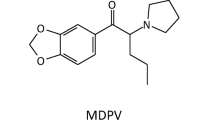Abstract
Purpose
4-Fluoroisobutyrylfentanyl (FIBF) was first identified at the New York City Office of Chief Medical Examiner (OCME) in May 2017 and was reported qualitatively due to the constant changes in “fentalogs” (analogs of fentanyl) identified. However, by the year’s end, FIBF was the fifth most common non-methadone synthetic opioid detected and a quantitative method was developed to better understand the significance of this compound.
Methods
A full quantitative validation was performed utilizing liquid chromatography–tandem mass spectrometry (LC–MS/MS). All cases submitted between May 2017 and December 2018 that tested positive for FIBF qualitatively were chosen for quantitation. In addition to compiling FIBF concentrations, user demographics and concurrent drug use were also investigated.
Results
There were 247 FIBF-positive cases that were tested with blood concentrations ranging from < 0.1 to 331 ng/mL. The most commonly detected drugs in conjunction with FIBF were other opioids, benzodiazepines, cocaine, cannabinoids and ethanol. The most frequent users were male, White, and between 35 and 54 years of age. The concentrations of FIBF varied widely and showed no clear distinction when considering various case types. Although most often used in tandem with other drugs of abuse, the danger of this compound was demonstrated by the fact that FIBF was also reported as the sole intoxicant responsible for death.
Conclusions
The development of a quantitative method for FIBF has been beneficial at the OCME due to the significant number of positive cases reported and the current lack of sufficient published information on this analog. To our knowledge, there are only two papers that include FIBF concentrations in four cases; this article gives the largest number (247 cases) of FIBF levels in blood samples of its users to aid in the interpretation and analysis of significance of this compound.



Similar content being viewed by others
References
WHO Expert Committee on Drug Dependence (2017) 4-Fluoroisobutyrfentanyl (4-FIBF): critical review report. https://www.who.int/medicines/access/controlled-substances/CriticalReview_4FIBF.pdf. Accessed 2 Feb 2019
EMCDDA (2017) EMCDDA-Europol Joint Report on a new psychoactive substance: N-(4-fluorophenyl)-N-(1-phenethylpiperidin-4-yl)isobutyramide (4-fluoroisobutryrylfentanyl; 4F-iBF). EMCDDA, Lisbon. https://www.emcdda.europa.eu/system/files/publications/5482/2017.4967_TDAS17007ENN_PDFWEB.pdf. Accessed 12 Mar 2019
NFLIS (2017) NFLIS-Drug 2017 Annual Report. US Drug Enforcement Administration. https://www.nflis.deadiversion.usdoj.gov/DesktopModules/ReportDownloads/Reports/NFLIS-Drug-AR2017.pdf. Accessed 12 Mar 2019
EMCDDA (2018) Risk assessments: 4F-iBF, report on risk assessment of N-(4-fluorophenyl)-2-methyl-N-[1-(2-phenylethyl)piperidin-4-yl)] propanamide in the framework of the Council Decision on new psychoactive substances. https://doi.org/10.2810/64132
DEA (2017) Schedules of controlled substances: temporary placement of 4-fluoroisobutyryl fentanyl into Schedule I. Federal Register vol 82, no. 84, pp 20544–20548. U.S. Government Publishing Office, Washington, D.C. https://www.deadiversion.usdoj.gov/fed_regs/rules/2017/fr0503.htm. Accessed 2 Feb 2019
NFLIS (2019) Special maps release: tracking fentanyl and fentanyl-related substances reported in NFLIS-drug by state, 2016–2017. US Drug Enforcement Administration. https://www.nflis.deadiversion.usdoj.gov/DesktopModules/ReportDownloads/Reports/NFLISDrugSpecialRelease-Fentanyl-FentanylSubstancesStateMaps-2016-2017.pdf Accessed 30 Jun 2019
Kahl JH, Gonyea J, Humphrey SM, Hime GW, Boland DM (2018) Quantitative analysis of fentanyl and six fentanyl analogs in postmortem specimens by UHPLC-MS-MS. J Anal Toxicol 42:570–580. https://doi.org/10.1093/jat/bky054
Helander A, Bäckberg M, Signell P, Beck O (2017) Intoxication involving acrylfentanyl and other novel designer fentanyls—results from the Swedish STRIDA project. Clin Toxicol 55:589–599. https://doi.org/10.1080/15563650.2017.1303141
SWGTOX (2013) Scientific Working Group for Forensic Toxicology (SWGTOX) standard practices for method validation in forensic toxicology. J Anal Toxicol 37:452–474. https://doi.org/10.1093/jat/bkt054
Palmquist KB, Swortwood MJ (2019) Data-independent screening method for 14 fentanyl analogs in whole blood and oral fluid using LC-QTOF-MS. Forensic Sci Int 297:189–197. https://doi.org/10.1016/j.forsciint.2019.02.006
Shoff EN, Zaney ME, Kahl JH, Hime GW, Boland DM (2017) Qualitative identification of fentanyl analogs and other opioids in postmortem cases by UHPLC-Ion Trap-MSn. J Anal Toxicol 41:484–492. https://doi.org/10.1093/jat/bkx041
Seither J, Reidy L (2017) Confirmation of carfentanil, U-47700 and other synthetic opioids in a human performance case by LC-MS-MS. J Anal Toxicol 41:493–497. https://doi.org/10.1093/jat/bkx049
New York State Department of Health (2018) New York State opioid annual drug report 2018. https://www.health.ny.gov/statistics/opioid/data/pdf/nys_opioid_annual_report_2018.pdf. Accessed 27 Jun 2019
Author information
Authors and Affiliations
Corresponding author
Ethics declarations
Conflicts of interest
The authors have no conflicts of interest to declare.
Ethical approval
This article does not contain any studies with human participants or animals performed by any of the authors, and all toxicological testings were made according to judicial requirement.
Additional information
Publisher's Note
Springer Nature remains neutral with regard to jurisdictional claims in published maps and institutional affiliations.
Electronic supplementary material
Below is the link to the electronic supplementary material.
Rights and permissions
About this article
Cite this article
Pardi, J., Toriello, A. & Cooper, G. Evaluation of 4-fluoroisobutyrylfentanyl in blood samples from 247 authentic cases submitted to the New York City Office of Chief Medical Examiner in 2017–2018. Forensic Toxicol 38, 340–351 (2020). https://doi.org/10.1007/s11419-019-00518-6
Received:
Accepted:
Published:
Issue Date:
DOI: https://doi.org/10.1007/s11419-019-00518-6




